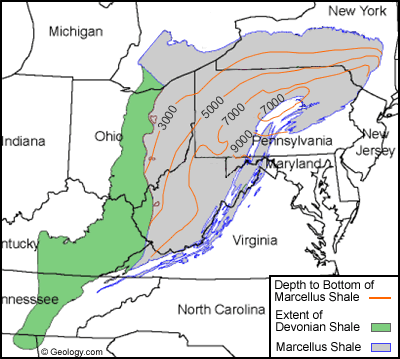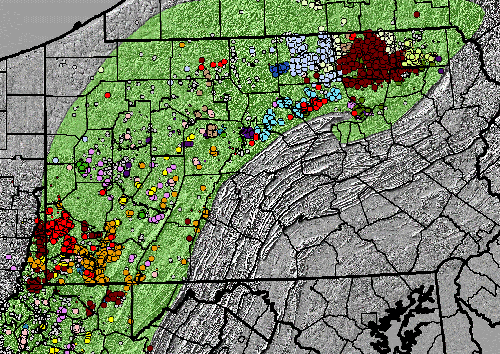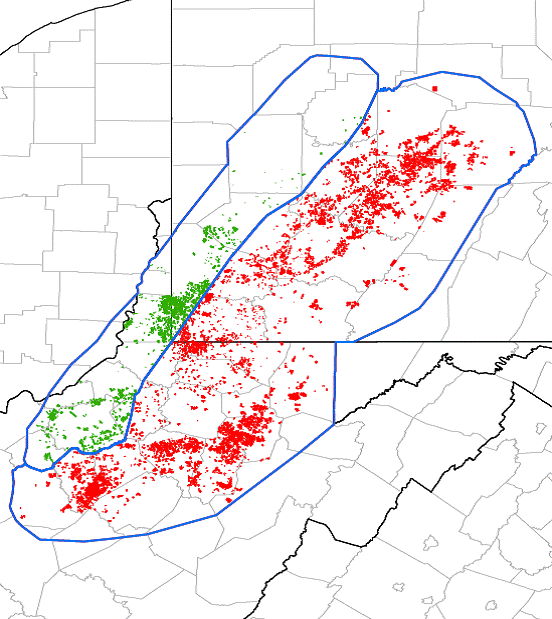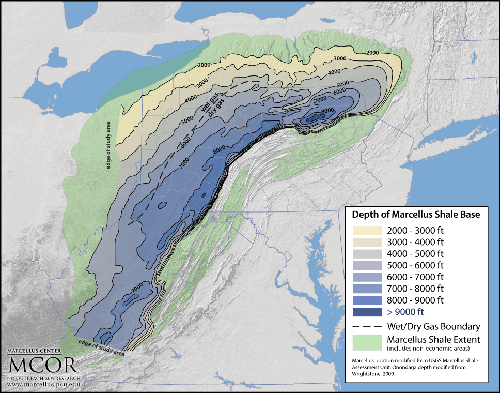The Marcellus shale is located in the Appalachian Basin and extends from southern New York to the western tip of Virginia from north to south. From east to west it begins at the eastern most point of Pennsylvania to central Ohio. The Marcellus covers 170,000 square miles. The illustration below shows its depth at 3,000 feet in central Ohio and deepens to 9,000 feet in the east. Shale thickness reaches 890 feet in New Jersey and thins to the west where it decreases to 49 feet in Ohio. Shale thickness decreases to the north and can be found in Canada at 40 feet. In West Virginia, the Marcellus is 200 feet thick. In 2002, the United States Geological Survey (USGS) estimated the Marcellus to have only 1.9 Tcf of recoverable gas. This estimate increased significantly when the U.S. Department of Energy increased the number of recoverable gas to 262 Tcf. Although natural gas has fallen out of favor given its price, the Marcellus does produce a high level of NGLs in some areas. There are a significant number of players here with very large acreages.
Exxon has over 700,000 net acres in the Marcellus. In 2011, it added 310,000 net acres to its current holdings with the purchase of Phillips Companies. Last year, production tripled.
Statoil entered into the Marcellus in 2008, with its purchase of a 32.5% working interest in Chesapeake's 1.8 million acres. This year, Statoil estimates its production will increase to 50 MBOE/D.
Anadarko has a 50% interest in 625,000 gross acres in the Marcellus. It currently has 150 producing wells and currently has seven operated and seven non-operated rigs running.
EOG Resources has 220,000 net acres in the Marcellus. It is holding this asset until natural gas pricing improves. The company will operate one rig in Pennsylvania this year.
Marathon currently has 80,000 net acres in the Marcellus. This acreage is located in Pennsylvania and West Virginia.
Chesapeake is the No.1 leaseholder in the Marcellus with 1.8 million acres. It is the second largest producer and the most active driller. It recently increased its EURs per well from 4.2 billions of cubic feet equivalent (BCFE) to 5.2 BCFE per well.
Talisman has 200,000 net acres in the Marcellus with EURs in the Marcellus being 5 billions of cubic feet (BCF) per well and a 30-day IP rate of 4 million cubic feet (MMCF) per day. In 2012, it will spend $600 million of capex. The company is decreasing its rig count from 11 in 2011 to seven or less by year end.
Southwestern Energy has 186,893 net acres in the Marcellus. In 2011, it invested $332 million and participated in 45 wells. By the end of 2011, it was 23.4 BCF compared to just 1 BCF in 2010. Horizontal well costs have averaged $6.4 million, with a lateral of 4,007 feet and 12 frac stages. It plans to spend $526 million in 2012 to complete 70 to 75 net wells. It will have three rigs running.
Range Resources has 750,000 net acres in the Marcellus Fairway. Range will spend 63% of its 2012 capex on southwest Marcellus and an additional 23% on the northeast Marcellus. Its southwest Marcellus acreage is liquids rich. Its acreage in Washington, Beaver and Allegheny counties has super-rich and wet gas. The average wet gas well has a lateral of 2,981 feet with 10 stages and has EURs of 281 thousand barrels (MBBLS) of condensate and NGLs, plus 4.2 BCF. Additional revenue is garnered from ethane at 55 cents per gallon. Average well costs are $4 million. The super-rich areas of Washington and Beaver counties have lateral lengths of 3,742 feet and 14 frac stages. It produces EURs of 400 MBBLS of condensate and NGLS plus 3.9 BCF. Well costs are $4.7 million. The image below shows wells in red that belong to Range Resources. The southwestern portion of Pennsylvania is liquids rich and northern West Virginia continues this trend. NGLs from 2009 to 2011 have followed the price of WTI. A barrel of NGL will typically trade for 52% of WTI's pricing, or around $53 per barrel, which improves further when ethane pricing is added.
Shell acquired 650,000 net acres in the Marcellus with its $4.7 billion purchase of East Resources.
Chevron has 714,000 net acres in the Marcellus. It acquired this with the purchase of Atlas Energy. This acreage adds potentially recoverable resource of 14 Tcf. It is a 60% operator in a JV with Reliance Industries in the Marcellus.
Consol has 50% of 628,000 net acres in the Marcellus. There are 161,000 net acres in the liquids-rich window. The image below shows Consol's acreage.
EQT Corp. has 530,000 net acres in the Marcellus with an average lateral length of 5,300 feet and well costs of $6.5 million. Expected EURs are 7.3 BCFE per well. The company plans to drill 132 wells in 2012, with 74 wells in southwestern Pennsylvania. EUR improvements of 20 to 25% are expected this year with changes to completion design with costs of $1.4 million.
Cabot has more than 150,000 net acres in the Marcellus. It has 125 horizontals and 37 vertical wells producing, and has five horizontal capable rigs running. Cabot has 15 of the top 20 producing wells in the Marcellus, including the top two.
SM Energy has 42,000 net acres in the Marcellus. It had originally tried to divest this acreage to Endeavour. In December 2011, Endeavour announced it terminated the deal.
National Fuel Gas Company (NYSE:NFG) has 745,000 net acres in the Marcellus. In response to low natural gas prices, it has reduced its rig count from six to four in 2012. Its JV with EOG Resources allows for non-operated wells, and the JV brings the total of net rigs to 5.5. Its acreage is in two areas: the western Marcellus is in the northwestern Marcellus Fairway and 100,000 net acres are prospective for wet gas including McKean, Forest, Elk and Clarion counties.
Ultra Petroleum (NYSE:UPL) has 260,000 net acres in the Marcellus. Its holdings are in north central Pennsylvania. The Marcellus has an average depth of between 5,600 and 7,500 feet. Well costs are between $6.7 million and $7.9 million, and EURs in Clinton/Lycoming are 7 BCFE and 5 BCFE in Potter/Tioga. Ultra will spend $925 million in 2012 capex and 44% will be spent in the Appalachia. Well spacing has been reduced to 110 acres. Ultra's best wells have been in southeast Tioga County, with an average IP rate of 8 MMCF/D.
EXCO Resources has 326,000 net acres in Appalachia, with four rigs running. There are 140,000 net acres in the Marcellus that have potential. It has well costs of $6.3 million.
Stone Energy has 72,000 net acres in the Marcellus. It has 13,000 net acres in northeast Pennsylvania, 31,000 net acres in central Pennsylvania and 28,000 net acres in southwest Pennsylvania. Its southwest acreage is in the Marcellus sweet spot, which is prospective for NGLs. Stone has planned to drill 22 to 27 horizontal wells and frac 20 to 26. It plans to focus on the southwest and large liquids content.
Carrizo has 100,595 net acres in the Marcellus. It is participating in two JVs. The first is with Reliance and the second is with Avista Capital Partners. The northeastern portion of Carrizo's operations have a well cost of $6.8 million and EURs of 7 BCF.
Magnum Hunter has 58,426 net acres in the Marcellus, and 25% of its $200 million 2012 capex will be spent on the Appalachia. It is focusing on its acreage in northern West Virginia due to high liquids production. Of its completions in Tyler and Wetzel counties, Magnum has had IP rates above 9.4 MMCF/D and up to 10.5 MMCF/D. These rates have been somewhat consistent with laterals of 5,000 feet and 16 frac stages.
PDC Energy has 151,891 net acres in the Marcellus shale with 142,569 acres in West Virginia and the rest in Pennsylvania. EURs run from 5 to 7 BCF with horizontal wells. Well costs are $6.5 million.
REX Energy has 66,400 net acres in the Marcellus. Its Butler County acreage consists of 44,800 net acres. Wells in Butler cost $5.3 million using a lateral of 3,500 feet. EURs are 5.3 BCFE and NGLs with current ethane recovery are 1.64 gallons per MCF. Westmoreland County wells cost $5.8 million and have EURs of 4.2 BCF.
Penn Virginia has 52,000 net acres in the Marcellus, and 35,000 net acres are in the counties of Tioga and Potter in Pennsylvania. It has no plans for new wells here until 2013 as production is almost entirely of dry gas.
Enerplus has 110,000 net acres in the Marcellus. Its acreage is located in northeast Pennsylvania and northern West Virginia. The latter is prospective for condensate and NGLs. The company estimates well costs at $7 million with EURs of 7 to 9 BCF. It will spend $190 million of the 2012 capex to get approximately 20 net wells on line.
Gastar has 76,100 net acres in the Marcellus and two rigs running. It has 14,100 net acres in Marshall and Wetzel counties, which produces condensate and ultra-rich gas. It also has two other prospective areas with 5,900 net acres in Butler County and 56,100 net acres in southwest to central Pennsylvania. Its 2012 capex is $134 million but $103 million will be spent on the liquids-rich counties of Marshall and Wetzel. In Butler County, 2,450 net acres also has rich, wet gas.
The Marcellus, due to a lower natural gas price, is currently not economic in some areas. The sweet spot seems to be in the southwest portion of the play. Emphasis should be placed on the southwest Pennsylvania border. This acreage is in both West Virginia and Pennsylvania, and has significant upside with respect to condensate, liquefied natural gas and ethane production. Liquids production also increases to the west while well costs improve as the depth of shale reduces to around 5,000 feet.
Areas in northwest Pennsylvania are also better, given the higher percentage of liquids and the decreased depth of shale. Although much of the Marcellus is not economic at this time, look for big purchases in the gassy areas as bigger companies try to buy acreage it can hold on to until gas pricing improves. It is still economic to drill the liquids-rich areas of this play.
Guide To Oil And Gas Plays In North America: Conclusion
Exxon has over 700,000 net acres in the Marcellus. In 2011, it added 310,000 net acres to its current holdings with the purchase of Phillips Companies. Last year, production tripled.
Statoil entered into the Marcellus in 2008, with its purchase of a 32.5% working interest in Chesapeake's 1.8 million acres. This year, Statoil estimates its production will increase to 50 MBOE/D.
 |
|
Figure 16: A map showing the Marcellus at a depth of 3,000 feet in central Ohio and deepening to 9,000 feet in the east. Shale thickness reaches 890 feet in New Jersey and thins to the west, where it decreases to 49 feet in Ohio. |
| Image: Geology.com |
Anadarko has a 50% interest in 625,000 gross acres in the Marcellus. It currently has 150 producing wells and currently has seven operated and seven non-operated rigs running.
EOG Resources has 220,000 net acres in the Marcellus. It is holding this asset until natural gas pricing improves. The company will operate one rig in Pennsylvania this year.
Marathon currently has 80,000 net acres in the Marcellus. This acreage is located in Pennsylvania and West Virginia.
Chesapeake is the No.1 leaseholder in the Marcellus with 1.8 million acres. It is the second largest producer and the most active driller. It recently increased its EURs per well from 4.2 billions of cubic feet equivalent (BCFE) to 5.2 BCFE per well.
Talisman has 200,000 net acres in the Marcellus with EURs in the Marcellus being 5 billions of cubic feet (BCF) per well and a 30-day IP rate of 4 million cubic feet (MMCF) per day. In 2012, it will spend $600 million of capex. The company is decreasing its rig count from 11 in 2011 to seven or less by year end.
Southwestern Energy has 186,893 net acres in the Marcellus. In 2011, it invested $332 million and participated in 45 wells. By the end of 2011, it was 23.4 BCF compared to just 1 BCF in 2010. Horizontal well costs have averaged $6.4 million, with a lateral of 4,007 feet and 12 frac stages. It plans to spend $526 million in 2012 to complete 70 to 75 net wells. It will have three rigs running.
Range Resources has 750,000 net acres in the Marcellus Fairway. Range will spend 63% of its 2012 capex on southwest Marcellus and an additional 23% on the northeast Marcellus. Its southwest Marcellus acreage is liquids rich. Its acreage in Washington, Beaver and Allegheny counties has super-rich and wet gas. The average wet gas well has a lateral of 2,981 feet with 10 stages and has EURs of 281 thousand barrels (MBBLS) of condensate and NGLs, plus 4.2 BCF. Additional revenue is garnered from ethane at 55 cents per gallon. Average well costs are $4 million. The super-rich areas of Washington and Beaver counties have lateral lengths of 3,742 feet and 14 frac stages. It produces EURs of 400 MBBLS of condensate and NGLS plus 3.9 BCF. Well costs are $4.7 million. The image below shows wells in red that belong to Range Resources. The southwestern portion of Pennsylvania is liquids rich and northern West Virginia continues this trend. NGLs from 2009 to 2011 have followed the price of WTI. A barrel of NGL will typically trade for 52% of WTI's pricing, or around $53 per barrel, which improves further when ethane pricing is added.
 |
|
Figure 17: The red dots indicate wells that belong to Range Resources. |
Shell acquired 650,000 net acres in the Marcellus with its $4.7 billion purchase of East Resources.
Chevron has 714,000 net acres in the Marcellus. It acquired this with the purchase of Atlas Energy. This acreage adds potentially recoverable resource of 14 Tcf. It is a 60% operator in a JV with Reliance Industries in the Marcellus.
Consol has 50% of 628,000 net acres in the Marcellus. There are 161,000 net acres in the liquids-rich window. The image below shows Consol's acreage.
 |
|
Figure 18: Consol\'s acreage is shown in red and green. The red is dry gas, while the green is liquids-rich. |
EQT Corp. has 530,000 net acres in the Marcellus with an average lateral length of 5,300 feet and well costs of $6.5 million. Expected EURs are 7.3 BCFE per well. The company plans to drill 132 wells in 2012, with 74 wells in southwestern Pennsylvania. EUR improvements of 20 to 25% are expected this year with changes to completion design with costs of $1.4 million.
Cabot has more than 150,000 net acres in the Marcellus. It has 125 horizontals and 37 vertical wells producing, and has five horizontal capable rigs running. Cabot has 15 of the top 20 producing wells in the Marcellus, including the top two.
SM Energy has 42,000 net acres in the Marcellus. It had originally tried to divest this acreage to Endeavour. In December 2011, Endeavour announced it terminated the deal.
National Fuel Gas Company (NYSE:NFG) has 745,000 net acres in the Marcellus. In response to low natural gas prices, it has reduced its rig count from six to four in 2012. Its JV with EOG Resources allows for non-operated wells, and the JV brings the total of net rigs to 5.5. Its acreage is in two areas: the western Marcellus is in the northwestern Marcellus Fairway and 100,000 net acres are prospective for wet gas including McKean, Forest, Elk and Clarion counties.
Ultra Petroleum (NYSE:UPL) has 260,000 net acres in the Marcellus. Its holdings are in north central Pennsylvania. The Marcellus has an average depth of between 5,600 and 7,500 feet. Well costs are between $6.7 million and $7.9 million, and EURs in Clinton/Lycoming are 7 BCFE and 5 BCFE in Potter/Tioga. Ultra will spend $925 million in 2012 capex and 44% will be spent in the Appalachia. Well spacing has been reduced to 110 acres. Ultra's best wells have been in southeast Tioga County, with an average IP rate of 8 MMCF/D.
EXCO Resources has 326,000 net acres in Appalachia, with four rigs running. There are 140,000 net acres in the Marcellus that have potential. It has well costs of $6.3 million.
Stone Energy has 72,000 net acres in the Marcellus. It has 13,000 net acres in northeast Pennsylvania, 31,000 net acres in central Pennsylvania and 28,000 net acres in southwest Pennsylvania. Its southwest acreage is in the Marcellus sweet spot, which is prospective for NGLs. Stone has planned to drill 22 to 27 horizontal wells and frac 20 to 26. It plans to focus on the southwest and large liquids content.
Carrizo has 100,595 net acres in the Marcellus. It is participating in two JVs. The first is with Reliance and the second is with Avista Capital Partners. The northeastern portion of Carrizo's operations have a well cost of $6.8 million and EURs of 7 BCF.
Magnum Hunter has 58,426 net acres in the Marcellus, and 25% of its $200 million 2012 capex will be spent on the Appalachia. It is focusing on its acreage in northern West Virginia due to high liquids production. Of its completions in Tyler and Wetzel counties, Magnum has had IP rates above 9.4 MMCF/D and up to 10.5 MMCF/D. These rates have been somewhat consistent with laterals of 5,000 feet and 16 frac stages.
PDC Energy has 151,891 net acres in the Marcellus shale with 142,569 acres in West Virginia and the rest in Pennsylvania. EURs run from 5 to 7 BCF with horizontal wells. Well costs are $6.5 million.
REX Energy has 66,400 net acres in the Marcellus. Its Butler County acreage consists of 44,800 net acres. Wells in Butler cost $5.3 million using a lateral of 3,500 feet. EURs are 5.3 BCFE and NGLs with current ethane recovery are 1.64 gallons per MCF. Westmoreland County wells cost $5.8 million and have EURs of 4.2 BCF.
Penn Virginia has 52,000 net acres in the Marcellus, and 35,000 net acres are in the counties of Tioga and Potter in Pennsylvania. It has no plans for new wells here until 2013 as production is almost entirely of dry gas.
Enerplus has 110,000 net acres in the Marcellus. Its acreage is located in northeast Pennsylvania and northern West Virginia. The latter is prospective for condensate and NGLs. The company estimates well costs at $7 million with EURs of 7 to 9 BCF. It will spend $190 million of the 2012 capex to get approximately 20 net wells on line.
Gastar has 76,100 net acres in the Marcellus and two rigs running. It has 14,100 net acres in Marshall and Wetzel counties, which produces condensate and ultra-rich gas. It also has two other prospective areas with 5,900 net acres in Butler County and 56,100 net acres in southwest to central Pennsylvania. Its 2012 capex is $134 million but $103 million will be spent on the liquids-rich counties of Marshall and Wetzel. In Butler County, 2,450 net acres also has rich, wet gas.
 |
|
Figure 19: A map showing the location of Gastar\'s acreage and the acreage of its competitors. |
The Marcellus, due to a lower natural gas price, is currently not economic in some areas. The sweet spot seems to be in the southwest portion of the play. Emphasis should be placed on the southwest Pennsylvania border. This acreage is in both West Virginia and Pennsylvania, and has significant upside with respect to condensate, liquefied natural gas and ethane production. Liquids production also increases to the west while well costs improve as the depth of shale reduces to around 5,000 feet.
 |
|
Figure 20: Map showing both the depth of the Marcellus and the thickness. |
| Image: Marcellus Center for Outreach and Research |
Areas in northwest Pennsylvania are also better, given the higher percentage of liquids and the decreased depth of shale. Although much of the Marcellus is not economic at this time, look for big purchases in the gassy areas as bigger companies try to buy acreage it can hold on to until gas pricing improves. It is still economic to drill the liquids-rich areas of this play.
Guide To Oil And Gas Plays In North America: Conclusion
Related Articles
-
 Investing
InvestingHow Fracking Affects Natural Gas Prices
Whatever you think of fracking, it has done one thing: kept the price of natural gas from increasing any more than it has. -
 Investing
InvestingE&P Operators Drop Natural Gas PUD's
Several exploration and production companies have been forced to remove natural gas reserves from the proved category. -
 Insights
InsightsChesapeake Energy Divests Natural Gas Assets (CHK)
Chesapeake dumps 880,000 acres and 5,600 wells in Appalachia in an effort to refocus its natural gas portfolio. -
 Investing
InvestingSmall Cap Permian Players To Watch
The Permian Basin will remain an active area for oil and gas exploration and development in 2012. Investors should examine the many small capitalization players active in this basin. -
 Investing
InvestingFracking Can't Happen Without These Companies
With all the attention paid to fracking, what is are the good investment opportunities? Are the companies that extract oil and natural gas a good bet? -
 Insights
InsightsBill Gates Invests $80 Million in Arizona Smart City
Gates’s investment firm made the move shortly after Alphabet announced plans to build a “smart city” in Toronto. -
 Investing
InvestingKey Ratios For Analyzing Oil And Gas Stocks
Oil and gas investors need to focus on a different subset of ratios to analyze the growth and profitability of these companies. -
 Investing
InvestingGuide To Oil And Gas Plays In North America
Oil and gas shales in North America have been known for decades, but most investors don’t know it exists, or what is produced.



